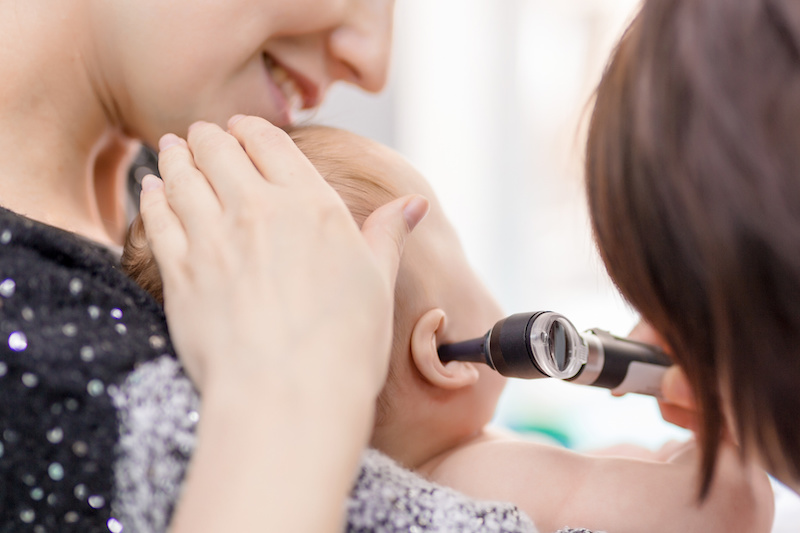 Kernodle Clinic - A DukeMedicine PRACTICE
Kernodle Clinic - A DukeMedicine PRACTICE
- Burlington 336-538-1234
- Mebane 919-563-2500
- Elon Family 336-538-2314
- Elon Pediatrics 336-538-2416
Ear Infections: What You Need to Know

Ear infections are one of the most common childhood illnesses with almost all children having at least one ear infection by the time they are 7 years old. They are also one of the most common reasons parents bring their child to a doctor. Some of the most common questions that we receive regarding ear infections include whether children always need an antibiotic to treat ear infections and when are ear infections considered chronic enough to require additional treatment like tubes. Here’s what you need to know about ear infections in children:
What is an Ear Infection?
According to the American Academy of Pediatrics, an ear is infected when the eustachian tube–the narrow passage connecting the middle ear (behind the eardrum) to the back of the throat– becomes blocked.
Ear infections can be caused by a virus, though they are more commonly caused by bacteria. Other conditions such as a cold, throat infection, acid reflux or allergies may also cause the ears to become infected.
Bacterial ear infections are commonly diagnosed in children under age 7, with most ear infections occurring between ages 6 months to 3 years. Young children are more susceptible due to the shorter length and more horizontal positioning of their eustachian tubes which let bacteria and viruses find their way into the middle ear more easily. These tubes are also narrower making them easier to become blocked.
What are the Symptoms?
Often, ear infections happen to children before they’ve learned how to talk. For kids that aren’t old enough to tell you that they’re ear hurts, here are some common signs their ear may be infected:
- Tugging or pulling at the ears
- Fussiness and crying
- Difficulty falling asleep or staying asleep
- Fever, especially in infants and younger children
- Fluid draining from the ear
- Clumsiness or problems with balance
- Trouble hearing or responding to quiet sounds
Can Ear Infections Be Prevented?
The best way to prevent ear infections is to reduce the risk factors associated with them.
- Prevent exposure to secondhand smoke, as this can increase the number and and severity of ear infections.
- Research indicates that breastfeeding an infant for at least 6 months can help to prevent the development of early ear infections.
- For babies that are bottle-fed, parents should hold the baby at an angle instead of lying him or her down with the bottle.
- As with any infection, the first line of defense is for parents and kids to wash their hands well and often to stop the spread of germs. This can help prevent viruses, such as the common cold, that may lead to ear infections.
- Stay up to date on immunizations, as certain vaccines can help prevent ear infections.
How Are Ear Infections Treated?
Middle ear infections often go away on their own within 2-3 days without any specific treatment. If the infection appears to be bacterial, your child’s pediatrician may prescribe antibiotics. As we learn more about the effects of the overuse of antibiotics, some doctors may recommend a wait and see approach depending on the severity of the infection before prescribing an antibiotic.
If your child has recurrent ear infections, your doctor may recommend additional treatment. Typically chronic ear infections are considered 4 or more in the past 12 months with at least 1 in the past 6 months, although if it is cold or flu season your pediatrician may want to give it additional time to see how your child does during other times of the year.
If the infections keep coming back and antibiotics aren’t helping, many doctors will recommend a surgical procedure that places a small ventilation tube in the eardrum to improve airflow and prevent fluid backup in the middle ear. The most commonly used tubes stay in place for six to nine months and require follow-up visits until they fall out.
If the placement of the tubes still doesn’t prevent infections, a doctor may consider removing the adenoids to prevent infection from spreading to the eustachian tubes.
When to See a Doctor
If your child has an earache, especially when combined with a fever, they should be seen by their pediatrician if their symptoms haven’t improved after a couple of days.
Ear infections share some similar symptoms with other types of earaches such as those caused by teething, swimmer’s ear (outer-ear infection), a foreign object in the ear or the build-up of hard earwax, so it’s important for your doctor to identify the cause of your child’s discomfort in order to effectively treat it.
To schedule an appointment, call Kernodle Pediatrics at 336-538-2416 for our Elon office or at 919-563-2500.
